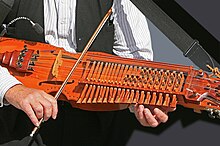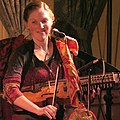Nyckelharpa
 | |
| Classification | |
|---|---|
| Hornbostel–Sachs classification | 321.322-71 |
| Related instruments | |
| |
A nyckelharpa (Swedish: [ˈnʏ̂kːɛlˌharːpa], "keyed fiddle", or literally "key harp", plural nyckelharpor) is a traditional Swedish musical instrument. It is a string instrument or chordophone. Its keys are attached to tangents which, when a key is depressed, serve as frets to change the pitch of the string.
The nyckelharpa is similar in appearance to a fiddle or the big Sorb geige or viol. Structurally, it is more closely related to the hurdy-gurdy, both employing key-actuated tangents to change the pitch.[1]
History[]

A depiction of two instruments, possibly but not confirmed nyckelharpor, can be found in a relief dating from c. 1350 on one of the gates of Källunge church in Gotland.[2][3] Early church paintings are found in Siena, Italy, dating to 1408 and in different churches in Denmark and Sweden, such as Tolfta church, Sweden, which dates to c. 1460–1525. Other very early pictures are to be found in Hildesheim, Germany, dating to c. 1590.
The Schlüsselfidel (nyckelharpa) is also mentioned in Theatrum Instrumentorum, a famous work written in 1620 by the German organist Michael Praetorius (1571–1621). The Swedish province of Uppland has been a stronghold for nyckelharpa music since the early 17th century, including musicians like (Carl Ersson Bössa, 1783–1847) from Älvkarleby.[3]
Changes by August Bohlin (1877–1949) in 1929/1930 made the nyckelharpa a chromatic instrument with a straight bow, making it a more violin-like and no longer a bourdon instrument.[3] Composer, player and maker of nyckelharpor Eric Sahlström (1912–1986) used this new instrument and helped to re-popularize it in the mid-20th century.[3] In spite of this, the nyckelharpa's popularity declined until the 1960s roots revival.
The 1960s and 1970s saw a resurgence in the popularity of the nyckelharpa, with notable artists such as Marco Ambrosini (Italy and Germany), Sture Sahlström, Hasse Gille, Peter Puma Hedlund and Nils Nordström including the nyckelharpa in both early music and contemporary music offerings. Continued refinement of the instrument also contributed to the increase in popularity, with instrument builders like and bringing innovation to the bow and body.
In 1990s, the nyckelharpa was recognised as one of the instruments available for study at the folk music department of the Royal College of Music in Stockholm (Kungliga Musikhögskolan). It has also been a prominent part of several revival groups in the later part of the century, including the trio Väsen, the more contemporary group Hedningarna, the Finnish folk music group Hyperborea and the Swedish folk music groups and Nordman. It has also been used in non-Scandinavian musical contexts, for example by the Spanish player Ana Alcaide, the English singer and multi-instrumentalist , and Sandra Schmitt of Storm Seeker, a Pirate Metal band from Germany.[4]
Technique[]

The nyckelharpa is usually played with a strap around the neck, stabilised by the right arm. Didier François, a violinist and nyckelharpist from Belgium, is noted for using an unusual playing posture, holding the nyckelharpa vertically[clarification needed] in front of the chest. This allows a wider range of motion for both arms. It also affects the tone and sound of the instrument. Some players may use a violin bracket to keep the nyckelharpa away from the body so that it can swing freely, causing it to sound more "open" as its resonance is not damped.
Variants[]
There are four common variants of the nyckelharpa still played today, differing in the number and arrangement of keys, number and arrangement of strings, and general body shape. The predominant type is the three-row so-called "chromatic nyckelharpa", with the melody strings tuned A1 - C1 - G, a drone C (from the highest to the lowest string) that is only touched occasionally, and 12 resonance strings (one for each step of the chromatic scale).
The resonance strings, or sympathetic strings, which were added to the instrument during the 2nd half of the 16th century, are not bowed directly but resonate with the other strings.
Traditional variants of the nyckelharpa used to have one or more drone strings. This is not the case for modern chromatic nyckelharpor with three rows of keys for three melody strings and one bass string. But there are today also types with four or even five rows of keys.
Gallery[]

Angel with viola a chiavi ('keys'), Cappellina di Palazzo Pubblico, Siena, Italy. Fresco by Taddeo di Bartolo, 1408.

Two angels with nyckelharpa, fresco in the church at Tolfa, Tierp Municipality, Uppland, Sweden. Unknown painter, 1503.

Schlüsselfidel at the "Knochenhaueramtshaus", Hildesheim, Germany, 1529.

Schlüsselfidel (lower right) shown in Michael Praetorius' Syntagma Musicum, 1619.

Bronwyn Bird, member of Blue Moose, plays the nyckelharpa at a concert in 2007. Photo by georgie grd.

Marco Ambrosini at Burg Fürsteneck, Germany, playing a nyckelharpa built by Annette Osann.

Didier François teaching his special technique at the International Days of the Nyckelharpa at Burg Fürsteneck, 2005.

Mia Gundberg Ådin (Huldrelokkk) playing the Nyckelharpa at the music festival Bardentreffen in Nuremberg, 2015.
See also[]
- Hardanger fiddle
- Hurdy-gurdy
- Music of Sweden
- Moraharpa
References[]
- ^ Ternhag, Gunnar; Boström, Mathias. "The Dissemination of the Nyckelharpa - The Ethnic and the non-Ethnic Ways". STM-Online vol. 2 (1999). Retrieved 25 December 2018.
- ^ Brashers, Bart. "A Brief History of the Nyckelharpa". American Nyckelharpa Association. Retrieved 25 December 2018.
- ^ Jump up to: a b c d Broughton, Simon; Ellingham, Mark; Lusk, Jon (28 September 2006). The Rough Guide to World Music Vol. 1: Africa and the Middle East. Rough Guides. p. 299. ISBN 978-1-85828-635-8.
- ^ "Sandra Schmitt - Encyclopaedia Metallum: The Metal Archives". www.metal-archives.com. Retrieved 2020-09-07.
External links[]
| Wikimedia Commons has media related to Nyckelharpa. |
- The American Nyckelharpa Association
- International Days of the Nyckelharpa (Germany)
- Nyckelharpa.eu Nyckelharpa Cooperation in Europe
- Kornel Mariusz Radwanski plays The Alchemist's Dance on nyckelharpa with James Kline on archharp-guitar on YouTube
- The UK Nyckelharpa Society
- What is a Nyckelharpa? on YouTube
- Bowed box zithers
- Nordic folk music
- String instruments with sympathetic strings
- Swedish musical instruments
- Swedish folk music
- Necked box lutes







